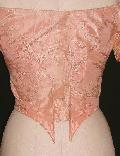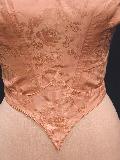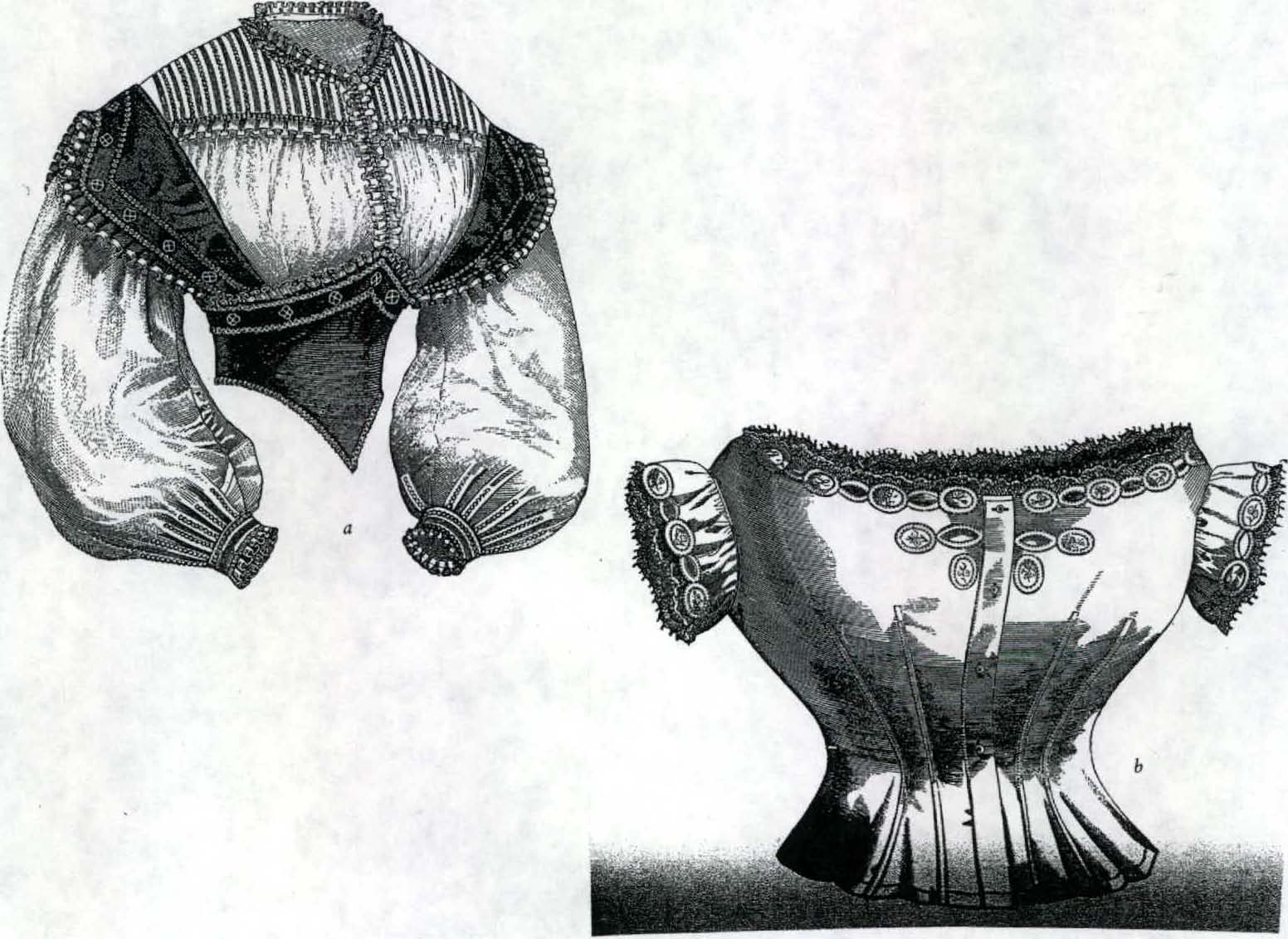This bodice, c. 1863, is made from silk brocade and has a Swiss belt. It is entirely hand-made although some recent additions/alterations were done by machine. The original pink has faded to salmon.
Construction Details
This bodice is made of a crisp silk brocade with a flower pattern. It was originally a light, bright pink. You can still find this color in the areas that have been covered by ribbon and folds while it was stored. It is now a salmon color with age. All of the original seams on this bodice are hand sewn. They are so well-done and closely sewn, that they appear to be machine sewn. The seams on the backs, the darts on the front and the shoulder seams are all edge-stitched.
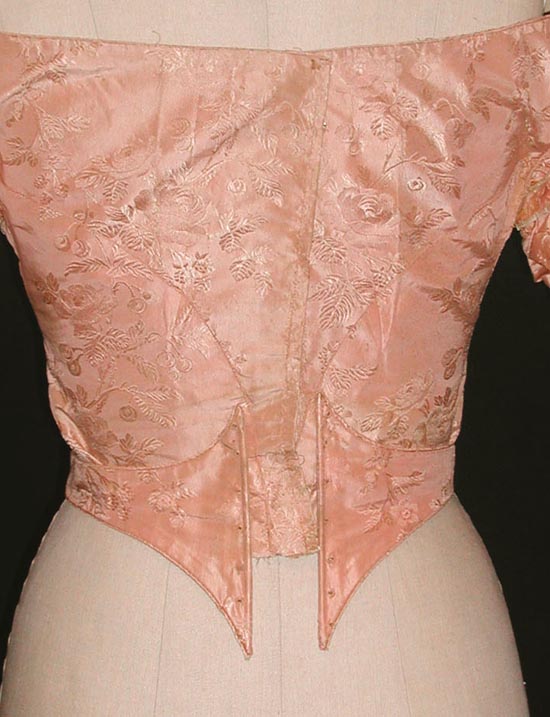 The center back pieces are slightly shaped at the bottom to bring in the waist. There have been changes in the hardware, it seems. The original thread still exists where the hooks and eyes used to be. It looks like there must have been loops on the left and hooks on the right facing the body. The hooks were set in 5/8". Now, the left has bars and the right has a 2-1/4" panel, (6-3/4" long), with eight hooks that go under the bars to hook and face away from the body. The panel is made of folded silk ribbon that was badly machine top-stitched to finish the long edge and badly whip-stitched to the bodice.
The center back pieces are slightly shaped at the bottom to bring in the waist. There have been changes in the hardware, it seems. The original thread still exists where the hooks and eyes used to be. It looks like there must have been loops on the left and hooks on the right facing the body. The hooks were set in 5/8". Now, the left has bars and the right has a 2-1/4" panel, (6-3/4" long), with eight hooks that go under the bars to hook and face away from the body. The panel is made of folded silk ribbon that was badly machine top-stitched to finish the long edge and badly whip-stitched to the bodice.
The flat-lining differs from the outside fabric. It follows the same grain, but is constructed in fewer pieces. The two center back pieces of the outside fabric are top-stitched right onto the one piece of flat-lining. The flat-lining is constructed as a separate piece and then flat-lined to the outside fabric. The center front of the flat-lining has a seam that the outside does not. There is also an extra dart not in the outside fabric. The flat-lining has an apparently unnecessary dart that comes from the side seam and goes to about the princess line area, 2" above the waist line.
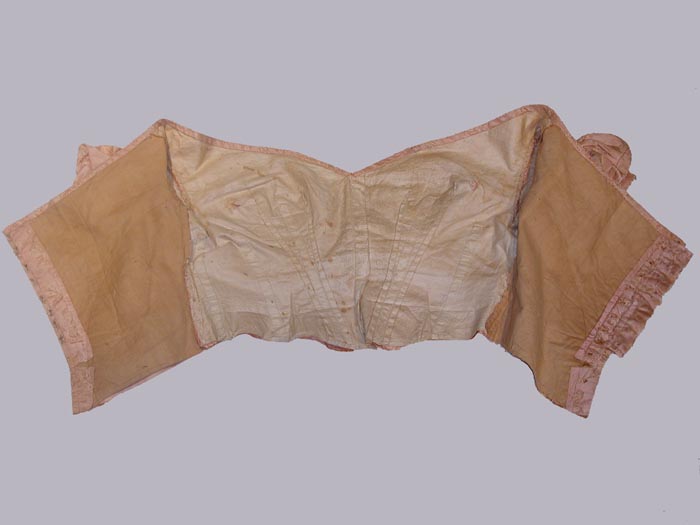
The center front seam of the flat-lining is where a bone used to be, pressed to the right side. All of the bones have been removed, but the tapes are still there, except for the back tapes. They are all bias tapes of the same fabric as the flat-lining. They are all at least 1/4" and under 7/16" which I suppose implies 1/4" bones.
All of the dart pick-ups are cut down. In the outside fabric there is no finishing of anything. All of the seams and darts of the flat-lining are toward the body, so they are finished with a small hand overcast. The outside fabric has the dart pick-ups all pressed away from the center. The flat-lining has a bone tape between the darts, so they are pressed away from the bone tape to either side.
For some reason, the back pieces of flat-lining are a different color than the fronts. At first I assumed that the backs must have been an alteration. But, I assume this is not true because it is doubtful that someone would have taken the time to re-do the back flat-lining and then put such a badly hand sewn dart on top of it.
There are two sets of darts and a side seam alteration that were obviously put in after the bodice was finished. The two back darts are badly hand sewn and don't exactly have a vanishing point. The two darts in front are machine-sewn, as are the side seam alterations. All of the four darts go through both layers of the bodice together, instead of separately. There are doubled ribbon straps, attached at about 3-1/2" from center back and center front, that were probably added also because the neckline was too low for the wearer.
There is a fading fold line on the bottom of the bodice, from 3-1/2" up at center back to 2-3/8" up at the dip in the center front, where a skirt may have been attached. There is also a line of thread that wraps around the neckline where perhaps there was a line of delicate lace that has come apart.
Sleeves and Belt
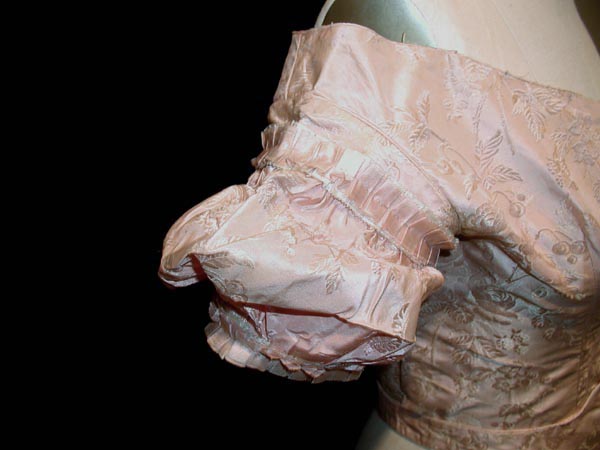 The sleeves are really interesting. Everything on the sleeves is bias except the ribbon. The flat-lining is bias, the flat strip at the top is bias, the cording, the puff and the other cords are all bias. The strip of outside fabric starts at 1" under the arm, then gets as wide as 1-1/2" at the top of the cap. It has a cord attached that is the seam between that and the 6" bias strip that makes the puff. This strip is gathered on all sides. It was gathered all the way around the top and gathered separately into each side of the underarm seam before it was seamed. The bottom gets gathered into the strip of cording that finishes the hem, except for 1" on each side of the underarm seam.
The sleeves are really interesting. Everything on the sleeves is bias except the ribbon. The flat-lining is bias, the flat strip at the top is bias, the cording, the puff and the other cords are all bias. The strip of outside fabric starts at 1" under the arm, then gets as wide as 1-1/2" at the top of the cap. It has a cord attached that is the seam between that and the 6" bias strip that makes the puff. This strip is gathered on all sides. It was gathered all the way around the top and gathered separately into each side of the underarm seam before it was seamed. The bottom gets gathered into the strip of cording that finishes the hem, except for 1" on each side of the underarm seam.
The trim on the sleeves consists of two rows of ribbon laid on top of each other. The row showing matches the pink silk ribbon, (13/16"), box-pleated from 3/8" to 1/2". The row under that is a white silk ribbon that's 1" to stick out and below the pink. They are box-pleated at the same size. They both had a feather edge that's mostly worn away. There are two doubled rows on each sleeve placed with the bottom of the ribbon edge just covering the top cord and the bottom of the second row just covering the bottom cord to make the hem edge.
The belt, in the Swiss style, is very sweet. It comes to two points in front and in back. The bottom point is longer than the top. There are two bones behind the two front points and one round whale bone on each side of the center backs. The belt is very narrow between the points. The center back curves in at the middle, probably because the waist is smaller than where the top and bottom points sit on the body, i.e. to make it look straight when laced. The eyelets are very small and hand-done, just past the bone.
Condition of the Garment
The fabric is discolored, stained and mildewed. There are small wear holes on the inside in that match from side to side, perhaps where the corset rubbed or where the eggs were taken out. The alterations and adjustments that were made possibly to fit a second wearer, made this bodice lose some of its elegance. The sloppy hand-stitching and the odd, uneven darts and straps make it less delicate. It is still a pretty piece though and a great way to look at history.
Dating
The reason I believe that this bodice and belt are from 1863 is because of the large evidence of Swiss belts I see in the period research. Also the shoulders being so far off of the shoulder are a large indicator. Around the late 1820s to early 1830s there seems to be much the same silhouette, but the sleeves in that period seem to come straight out from the shoulder, whereas the sleeves on this bodice are more similar to the 1860s where the sleeves flatten before they puff.
According to Blanche Payne in History of Costume, "Bodices maintained a snug fit throughout the 1850s and 1860s, with few exceptions. Some had basques, flared extensions below the waist; others ended in points at center front. Waistline levels began to rise in the middle 1860s." Payne also stated that "...but very revealing, off-the-shoulder necklines prevailed for evenings. In their zeal to make their waistlines look tiny, women shaped their bodices with vertical princess seams that converged toward the center of the waist in both front and back. Armscyes dropped onto the upper arm in both decades, contributing to a slope-shouldered look. Even the shoulder seams slanted toward the back to make the wearer appear smaller. Front closings gradually replaced back fastenings in the 1850's and were the norm in the 1860's. However, evening dresses hooked in back to create a smooth line in the bodice or "corsage"" (Payne 511-512).
| Illustrations below reproduced from Stella Blum, Fashions and Costumes from Godey's Lady's Book. |
|
|
Pattern
The bodice was drafted using 1/8" = 1" scale. No modern reproduction was created.
© Lia Tricarico Carpenter 2001



